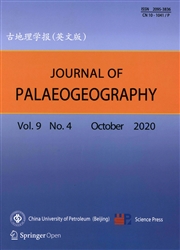Continental chemical weathering during the Early Cretaceous Oceanic Anoxic Event(OAE1b): a case study from the Fuxin fluvio-lacustrine basin, Liaoning Province,NE China
作者:Xiao-Tao Xu,Long-Yi Shao,Bo Lan,Shuai Wang,Jason Hilton,Jian-Yi Qin,Hai-Hai Hou,Jie Zhao
摘要:This study focuses on Early Cretaceous mudstones from the Shahai and Fuxin formations in the Fuxin continental basin. We analyse chemical weathering, land surface temperatures and palaeoclimates based on chemical weathering indices, and emphasize the implications of continental chemical weathering on nutrient fluxes into lakes and oceans.According to Cr and Ni abundance, Al2O3-TiO2, La/Sc-Th/Co and V-Ni-Th×10 plots, as well as rare earth element(REE)analysis, mudstone samples from the Shahai and Fuxin formations were derived from the same type of provenance comprising mainly felsic igneous rocks. Chemical weathering trends reflected by the Chemical Index of Alteration(CIA),Weathering Index of Parker(WIP) and the Mafic Index of Alteration for Oxidative weathering environments(MIA(O)) are consistent with each other and allow the geological succession to be divided into four stages. Land surface temperatures of the Shahai and Fuxin formations are estimated based on the linear relationship of CIA to temperature,and also can be divided into four stages consistent with those determined from chemical weathering trends. During Stage A(early part of the late Aptian) chemical weathering and land surface temperatures were relatively low and showed characteristic high fluctuations, while Stage B(latest Aptian) represented a transitional period where weathering rates and temperatures increased, and high amplitude fluctuations continued. Conditions changed markedly in Stage C(early Albian) with very high and stable weathering, and warm, humid climates, while in Stage D(middle and late Albian) conditions returned to low chemical weathering and land surface temperatures. These stages of chemical weathering and land surface temperature fluctuations represent responses to global climate fluctuations during the Early Cretaceous, with the early Albian high weathering intensities and warm, humid climates combining to create high nutrient levels that would have flushed through rivers into lakes and ultimately oceans. This correlates
发文机构:College of Geoscience and Surveying Engineering Shandong Key Laboratory of Depositional Mineralization&Sedimentary Mineral Northeast China Coalfield Geology Bureau 107 Exploration Team School of Geography College of Mining
关键词:ChemicalweatheringindicesLandsurfacetemperatureMUDSTONEGreenhouseconditionsOceanAnoxicEvent1bBlackshales
分类号: P59[天文地球—地球化学]P534.5[天文地球—地质学]
- Genus Pronephrium Presl 1851 (Thelypteridaceae) in Romania
- Ancient rip current records and their implications: an example from the Cretaceous Ukra Member, Kutch, India
- New freshwater plesiosaurian materials from the Middle Jurassic Xintiangou Formation of the Sichuan Basin, southwestern China
- First steps in reconstructing Early Jurassic sea water temperatures in the Andean Basin of northern Chile based on stable isotope analyses of oyster and brachiopod shells
- A facies and palaeogeography-based approach for analysis of petroleum systems in United Arab Emirates
- The complexity of climate reconstructions using the coexistence approach on Qinghai-Tibetan Plateau
- The use of mineral interfaces in sand-sized volcanic rock fragments to infer mechanical durability
- Fruits of Scirpus (Cyperaceae) from the early Miocene of Weichang,Hebei Province, North China and their palaeoecological and palaeobiogeographical implications
- Words of the Editor-in-Chief——some ideas about the comments and discussions of hyperpycnal flows and hyperpycnites
- Summary of Editorial Committee Meeting (January 5, 2020) of Journal of Palaeogeography


